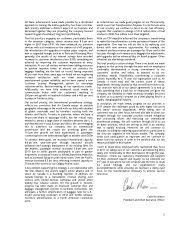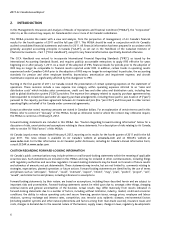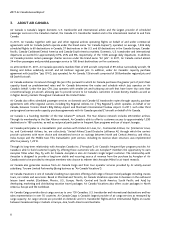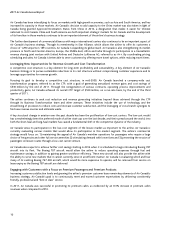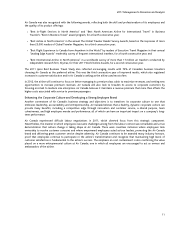Air Canada 2011 Annual Report Download - page 15
Download and view the complete annual report
Please find page 15 of the 2011 Air Canada annual report below. You can navigate through the pages in the report by either clicking on the pages listed below, or by using the keyword search tool below to find specific information within the annual report.2011 Management’s Discussion and Analysis
15
Domestic passenger revenues increased 5.9% from 2010
Domestic passenger revenues of $4,015 million in 2011 increased $225 million or 5.9% from 2010 due to yield and traffic
growth. The capacity growth in 2011 was mainly due to Air Canada’s new service from Toronto Island’s Billy Bishop Airport to
Montreal Trudeau Airport.
Components of the year-over-year change in domestic passenger revenues included:
The traffic increase which reflected growth on all major domestic services. The traffic increase was slightly above the
capacity growth, resulting in a slightly higher passenger load factor.
The yield increase which reflected growth on all major domestic services. The yield improvement was mainly due to fuel-
related fare increases to partly offset higher fuel prices. The yield improvement was achieved in spite of a $12 million
unfavourable impact of a stronger Canadian dollar on foreign currency denominated domestic passenger revenues.
The RASM growth was mainly due to the yield improvement.
U.S. transborder passenger revenues increased 14.8% from 2010
U.S. transborder passenger revenues of $2,064 million in 2011 increased $267 million or 14.8% from 2010 due to traffic and
yield growth. The capacity growth in 2011 mainly reflected an increase in frequencies on routes to California, Florida and Las
Vegas, as well as the addition of the airline’s new service to New Orleans. Components of the year-over-year change in U.S.
transborder passenger revenues included:
The traffic increase which reflected growth on all major U.S. transborder services and was in part due to sixth freedom
traffic flows from the U.S. (meaning U.S. originating traffic carried through points in Canada to other international
destinations) in support of Air Canada’s international expansion initiatives.
The yield improvement which was due to fuel-related fare increases to offset higher fuel prices. A gain in premium cabin
traffic was also a contributing factor. Yield improvements were recorded on all major U.S. transborder services with the
exception of routes to Hawaii where a more competitive pricing environment had a negative impact on yields. The yield
improvement was achieved in spite of a $31 million unfavourable impact of a stronger Canadian dollar on foreign
currency denominated U.S. transborder passenger revenues.
The RASM improvement was due to the higher yield and passenger load factor.
Atlantic passenger revenues increased 3.6% from 2010
Atlantic passenger revenues of $2,033 million in 2011 increased $71 million or 3.6% from 2010 due to traffic growth. The
capacity increase in 2011 was mainly due to additional frequencies on summer seasonal routes, including Montreal and
Toronto to Athens, Toronto to Barcelona and Madrid, and Toronto to Dublin. In addition, Air Canada operated an additional
Montreal to London Heathrow flight, as well as additional frequencies from Toronto to Copenhagen. Air Canada also operated
larger aircraft on flights from Toronto to Munich and Zurich and on its Toronto – Montreal to Brussels service. Components of
the year-over-year change in Atlantic passenger revenues included:
The traffic increase which reflected growth on all major Atlantic services, with the exception of routes to the United
Kingdom. The U.K. market continued to be challenged by the weak economic environment and additional competitive
pricing actions, impacting both local traffic and connecting markets over Air Canada’s London gateway. The traffic
increase was below the capacity growth, resulting in a lower passenger load factor.
The yield decline which was mainly due to the impact of increased competition and competitive pricing activities and the
continuing weak economic conditions in Europe. Despite this, premium cabin traffic experienced gains when compared to
2010. The yield decline was also due to a $13 million unfavourable impact of a stronger Canadian dollar on foreign
currency denominated Atlantic passenger revenues.
The RASM decrease was due to the lower passenger load factor and the decline in yield.


